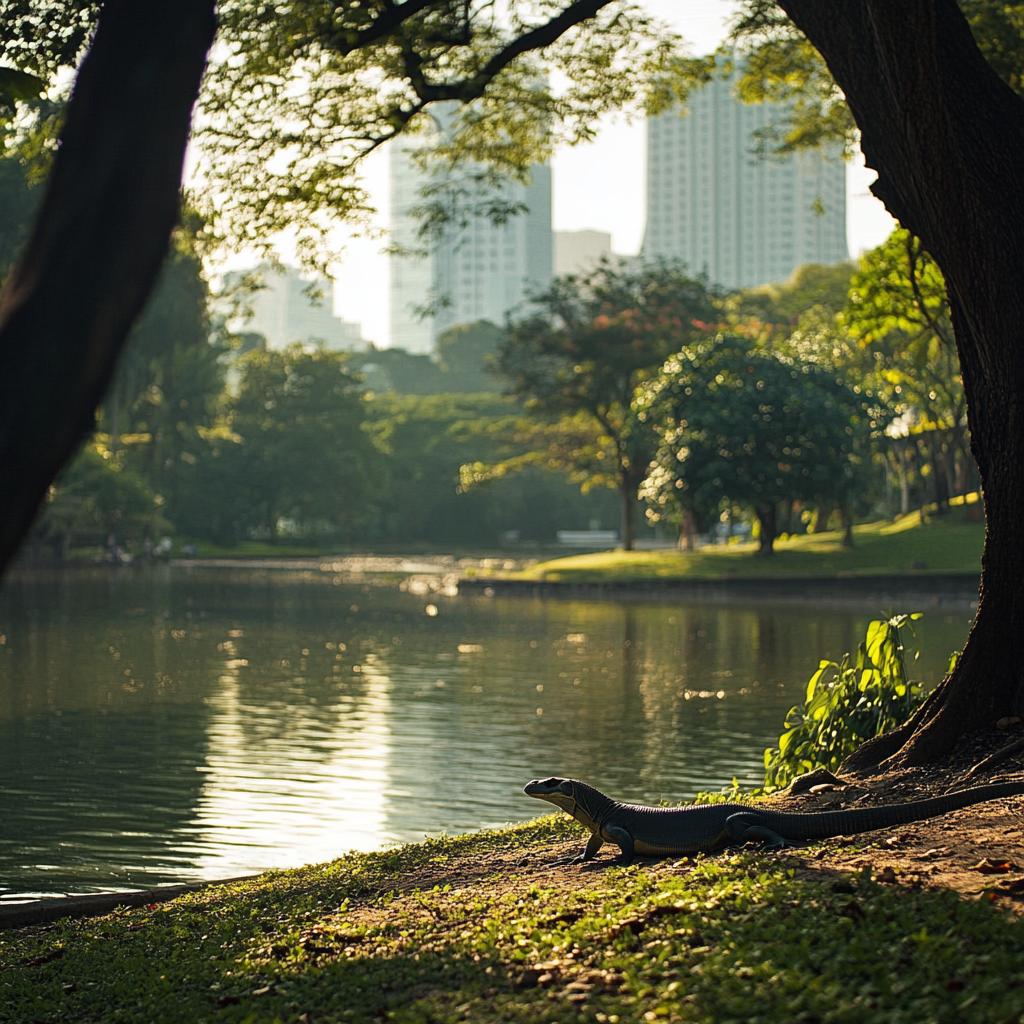In the bustling heart of Bangkok, an unlikely creature is stirring up quite the conversation. No, not the city’s ever-fabulous street food or its magnetic nightlife, but something more… scaly. We’re talking about the city’s water monitors, residing in none other than the urban oasis of Lumpini Park and alongside the canal that runs parallel to Rama IV Road. Like residents trying to balance the scales – quite literally – the Bangkok Metropolitan Administration (BMA) is diving deep into discussions about managing the burgeoning population of these remarkable reptiles.
The Environment Department of the BMA, spearheaded by the ever-dedicated Prapas Lueangsirinapha, has been on the lookout. Observing the water monitors like a compassionate zoologist armed with nothing more dangerous than a clipboard, Prapas made it clear that these creatures, while perhaps misunderstood, are bagged under a vital protective umbrella. They are safeguarded by the Wild Animal Conservation and Protection Act of BE 2562, a legislative sanctuary that prohibits any form of hunting, trading, or harm toward them. So while these lizards might not be adopting the city’s chaotic hustle, they’re definitely part of its legal tapestry.
Yet, why all the buzz over these lizard landlords of Lumpini? Despite their prehistoric appearance and the occasional travel article dubbing them as the “Thai Komodo dragons,” reports from the Zoological Park Organisation of Thailand assure that water monitors don’t pose a danger to humans unless, of course, you’re a carcass looking to be cleaned up. Functioning as nature’s own recycling enthusiasts, they perform a stellar job at tidying up the leftovers of the city’s unseen wildlife, and they’ll even dine on unwelcome guests like rats – bonus points for cleanliness!
Recognizing this delicate balance between coexistence and control, the BMA isn’t just putting out the welcome mat for these scaly dwellers. Instead, they’re on a mission to school both locals and tourists on how to harmonize their living arrangements. New campaigns aim to turn mystery into understanding, unraveling the enigma of water monitor behaviors so humans and monitors can dodge any uneasy neighborly conflicts.
Yet, even with understanding, discussions are afoot with none other than the Department of National Parks, Wildlife, and Plant Conservation. How to keep the water monitor numbers at bay while still maintaining the delicate ecosystem they contribute to? New strategies are set to be brainstormed, so stay tuned as the wisdom of Bangkok’s conservationists shines through.
Down in the throbbing heart of Pathumwan, a place that rivals even the busiest Bangkok kitchens, Ittipol Ingprasarn, who knows his district like the back of his hand, isn’t resting on laurels. Under his watchful eye, areas around Lumpini Park and the adjoining canal are undergoing a cleanliness renaissance. It’s not just about picking up litter, but about making the spaces less appetizing for the disease-carrying creatures that could potentially tag along with water monitors like uninvited dinner guests.
The Pathumwan district office isn’t stopping there. With active discussions on all fronts and collaborative brainstorming sessions hotter than a Bangkok summer day, they’re assessing every option. United with other local authorities, they’re sculpting a sustainable blueprint to keep human-lizard relations as cool as an evening river breeze.
In a city where tradition meets modern marvel, Bangkok’s water monitors are a testament to nature’s resilience. Not quite city mascots but more than mere inhabitants, they urge us to respect and reimagine how vibrant our urban ecosystems can be. So the next time you cross paths with one, give a nod to nature’s custodians keeping the wild and wonderful heart of Bangkok in check.


















It’s amazing that Bangkok is taking steps to coexist with these incredible creatures. They do an important job in managing waste.
Absolutely! People often fear what they don’t understand. It’s all about education and respect for nature.
Exactly, we need more educational campaigns. If people understood how beneficial these creatures are, the fear would lessen.
Easier said than done! Some people just don’t care about nature at all.
As a tourist, I find it fascinating to see such wildlife in the middle of a bustling city! It adds to Bangkok’s charm.
Tourists might find it charming, but those of us who live here face real challenges with these lizards.
Fair point! But isn’t it more about accommodating nature rather than combatting it?
Do we really need so many resources spent on these reptiles? Can’t we find a better use for city funds?
Well, conserving these animals might actually help save money in the long run by reducing disease vectors and managing waste effectively.
It’s not just about funds, it’s about understanding our environment and living responsibly within it.
I think using the water monitors to teach about ecosystems is a brilliant idea! It can change perceptions about wildlife.
Isn’t it ironic that as cities grow, we’re trying to balance nature we’ve already disrupted? Seems like a losing battle.
Perhaps, but it also shows our evolving understanding and respect for nature. Better late than never, right?
Just wait until one attacks a person, then people might change their tune about preservation.
That’s a fear-based myth. These creatures are not naturally aggressive; they just need their space.
It’s a testament to biodiversity! Let’s protect it, not fear it.
How big do these lizards get? I can’t imagine a giant creature roaming around freely!
Water monitors can grow up to 3 meters long, but they’re generally shy and avoid humans.
Are we supposed to be impressed by government actions that are ten years late? These lizards have been here forever!
Improvements take time, and at least they’re finally doing something!
Such creatures are more fearsome than anything! The city should prioritize safety.
Fear stems from ignorance. These animals rarely pose a threat and contribute significantly to our urban environment.
It’s fascinating how urban areas can become wildlife havens. Beyond Bangkok, these efforts inspire global conservation practices.
Absolutely, it’s a reminder that cities can be more than just concrete jungles.
Instead of complaining, why not appreciate that these creatures are a sign of a healthy ecosystem?
What about the imbalanced ecosystems these lizards might create elsewhere? There’s more to the equation than just appreciation.
True, but relocation strategies ensure that ecosystems aren’t adversely affected while maintaining ecological harmony.